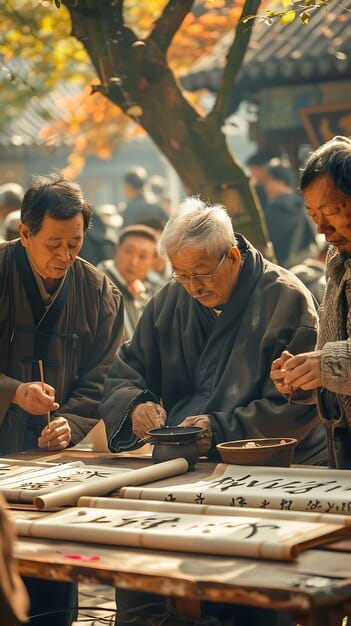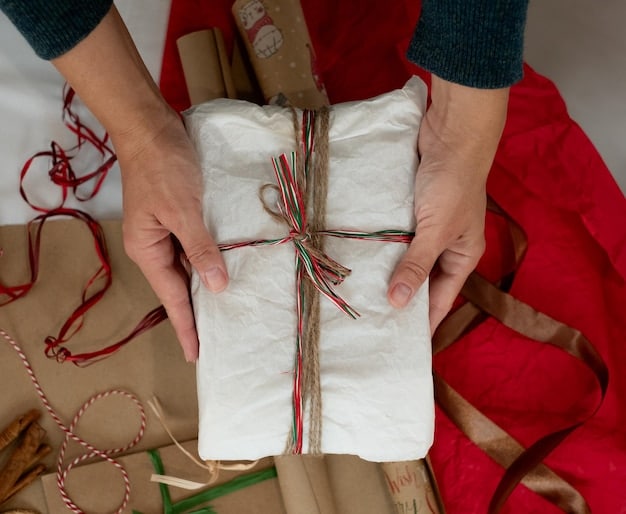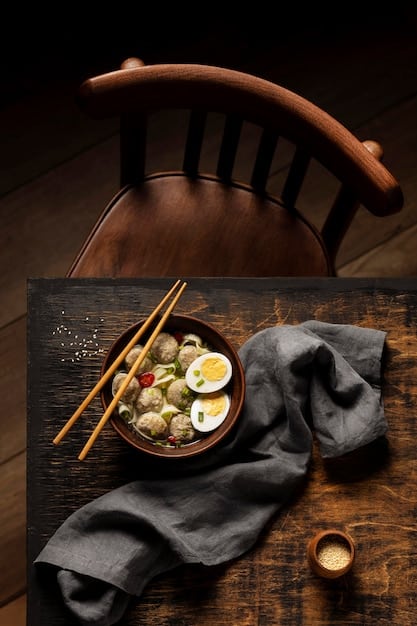Mastering Korean Etiquette: Essential Rules for Travel & Gatherings

Mastering Korean etiquette involves understanding and practicing essential rules related to bowing, dining, gift-giving, social interactions, and showing respect to elders, ensuring smooth interactions during trips to Korea or Korean gatherings.
Planning a trip to Korea or attending a Korean gathering? Mastering Korean etiquette is your key to showing respect and creating positive interactions. By understanding and practicing a few essential rules, you can navigate social situations with confidence and grace.
Understanding Korean Etiquette: Why It Matters
Korean culture highly values respect, harmony, and consideration for others. Understanding and adhering to Korean etiquette is crucial because it demonstrates your respect for their culture and traditions. It also facilitates smoother interactions and helps build positive relationships.
Ignorance of these customs can inadvertently cause offense or create misunderstandings. By learning and practicing basic Korean etiquette, you show that you value their culture and are making an effort to connect with them on a deeper level.
The Core Principles of Korean Etiquette
Korean etiquette is deeply rooted in Confucianism, which emphasizes hierarchical relationships and respect for elders. Understanding these principles is essential for navigating social situations in Korea.
- Respect for Elders: Age holds significant importance in Korean culture. Always show deference and respect to those older than you.
- Harmony and Conformity: Maintaining social harmony is crucial. Avoid behaviors that could be disruptive or cause embarrassment to others.
- Consideration for Others: Be mindful of the needs and feelings of others. This includes being punctual, polite, and avoiding overly direct confrontation.
- Modesty and Humility: Boasting or drawing attention to yourself is generally frowned upon. Instead, focus on humility and acknowledging the contributions of others.
Therefore, mastering the basics of Korean etiquette is not just about following rules; it’s about demonstrating your understanding and appreciation of Korean values.

Bowing: The Art of Korean Greetings
Bowing is an integral part of Korean greetings and displays of respect. It’s more than just a nod; it’s a nuanced gesture that communicates your level of deference and social standing.
Different bows convey different levels of respect, and understanding these nuances is essential for making a good impression.
How to bow correctly
The basic bow involves bending from the waist with your eyes directed downwards. The depth and duration of the bow depend on the context and the relationship between the individuals.
For casual greetings among equals, a slight nod or a quick bow is sufficient. However, when greeting elders, superiors, or someone you deeply respect, a deeper and longer bow is required. It is also important to maintain eye contact briefly before and after the bow to show sincerity. Always bow when greeting someone for the first time, offering thanks, or expressing apologies.
Knowing when and how to bow correctly can help you navigate social interactions and create a positive impression.
In conclusion, bowing is a fundamental aspect of Korean etiquette, and mastering its nuances demonstrates respect and cultural sensitivity.
Dining Etiquette: A Guide to Korean Table Manners
Dining in Korea is a social experience, and proper table manners are essential for showing respect and enjoying a harmonious meal. From seating arrangements to chopstick etiquette, there are several customs to be aware of.
Following these guidelines will help you navigate meal times with confidence and grace.
Seating and Serving
In traditional Korean dining, the eldest person is seated first, usually at the head of the table. Younger guests should wait for the elder to begin eating before starting their own meal.
When serving others, use both hands to offer food or drinks, especially to elders or superiors. This shows respect and attentiveness. Likewise, when receiving something, use both hands to accept it graciously.
- Wait for Elders to Begin: Always wait for the eldest person at the table to take the first bite before you start eating.
- Serving Others: When offering drinks or food to someone, especially an elder, use both hands to show respect.
- Receiving: Similarly, accept drinks or food offered to you with both hands.
Understanding these seating and serving customs is crucial for showing respect and participating in a harmonious dining experience.
Chopstick Etiquette
Chopsticks are the primary eating utensil in Korea, and there are several important rules to follow when using them. Sticking chopsticks upright in a bowl of rice is considered extremely impolite, as it resembles incense offerings at funerals.
Avoid using chopsticks to spear food or to move dishes around. Instead, use them to gently pick up morsels of food and bring them to your mouth. Rest your chopsticks on the chopstick rest when not in use, rather than placing them on the table or across your bowl.
Dining etiquette in Korea reflects the country’s deep-seated respect for hierarchy, tradition, and communal harmony.

Gift-Giving: Customs and Considerations
Gift-giving is a common practice in Korean culture, and it’s often used to express gratitude, appreciation, or congratulations. However, there are certain customs and considerations to keep in mind when giving gifts in Korea.
Understanding these customs can help you choose appropriate gifts and present them in a respectful manner.
Choosing the Right Gift
When selecting a gift, consider the recipient’s age, status, and relationship to you. Practical and consumable gifts, such as food, beverages, or household items, are generally well-received.
Avoid giving gifts that are overly extravagant or personal, as this could make the recipient feel uncomfortable. Red is considered a lucky color, so wrapping gifts in red paper or using red ribbons is a nice touch. However, avoid writing names in red ink, as this is traditionally associated with death.
- Presentation Matters: Wrap gifts neatly and use both hands when presenting them, especially to elders or superiors.
- Avoid Extravagance: Overly expensive or personal gifts can make the recipient uncomfortable.
- Lucky Colors: Red is considered a lucky color in Korea, so use it for wrapping or ribbons.
Gift-giving has its importance in Korean culture, reflecting the importance of relationships and reciprocity.
Social Interactions: Navigating Conversations and Customs
Social interactions in Korea are guided by certain customs and etiquette rules that are designed to maintain harmony and show respect. From addressing people appropriately to understanding body language, there are several aspects to be aware of.
Being mindful of these customs will help you navigate social situations with confidence and build positive relationships.
Addressing People
In Korea, it’s important to address people using appropriate titles and honorifics. Use “ssi” (씨) after a person’s full name or first name to show politeness. For elders or superiors, use their title (e.g., “director,” “professor”) followed by “nim” (님).
Avoid using someone’s first name unless you have been given permission to do so. When introducing yourself, state your full name clearly and offer a slight bow.
- Use Titles and Honorifics: Always address people with appropriate titles and honorifics to show respect.
- Avoid First Names: Unless given permission, avoid using someone’s first name.
- Introduce Yourself Clearly: When introducing yourself, state your full name and offer a slight bow.
Therefore, paying attention to these subtleties is crucial for building rapport and creating positive impressions.
Body Language
Body language also plays a significant role in Korean social interactions. Avoid making direct eye contact for prolonged periods, as this can be interpreted as confrontational or disrespectful. When sitting, avoid crossing your legs, especially in the presence of elders or superiors, as this is considered informal.
Therefore, being mindful of your body language can help you navigate social situations and avoid causing offense.
Showing Respect to Elders: A Cornerstone of Korean Culture
Respect for elders is a fundamental aspect of Korean culture, deeply rooted in Confucian values. Showing deference and consideration to those older than you is essential for demonstrating good manners and building positive relationships.
Understanding the various ways to show respect to elders can help you navigate social situations and earn the respect of others.
Language and Communication
When speaking to elders, use polite and respectful language. Use honorific verb endings and avoid using slang or casual expressions. Listen attentively and avoid interrupting them when they are speaking.
Using respectful language and demonstrating active listening skills are important for showing deference and creating positive interactions.
- Use Honorific Language: When speaking to elders, use polite and respectful language.
- Listen Attentively: Pay attention when elders are speaking and avoid interrupting them.
- Offer Assistance: Whenever possible, offer assistance to elders, such as carrying their belongings or helping them with tasks.
Showing genuine care and concern for elders is highly valued in Korean culture and can help you build strong and meaningful relationships.
| Key Point | Brief Description |
|---|---|
| 🙏 Bowing | Show respect through proper bowing techniques. |
| 🥢 Dining | Follow table manners, especially chopstick etiquette. |
| 🎁 Gift-Giving | Choose appropriate gifts and present them respectfully. |
| 👴 Respect Elders | Demonstrate deference through language and actions. |
Frequently Asked Questions
▼
Bowing is a fundamental way to show respect and acknowledge social hierarchy in Korea, reflecting Confucian values and signifying deference to elders or superiors.
▼
Avoid sticking chopsticks upright in rice, spearing food, or lifting your bowl to your mouth, as these actions are considered impolite and disrespectful at the Korean dining setting.
▼
Practical and consumable gifts like food, beverages, or household items are generally well-received. Avoid overly extravagant or personal gifts that may make the recipient uncomfortable during exchange.
▼
Adress elders with their title followed by “nim,” and always use honorific verb endings to show respect in communication as this will strengthen your relationship with them.
▼
Avoid prolonged direct eye contact, as it can be interpreted as confrontational or disrespectful. Brief eye contact is acceptable, but maintain a respectful distance during social interactions with Korean counterparts.
Conclusion
Mastering Korean etiquette is essential for creating positive and respectful interactions during your trip to Korea or when attending Korean gatherings. By understanding and practicing these essential rules, you can navigate social situations with confidence and demonstrate your appreciation for Korean culture.





